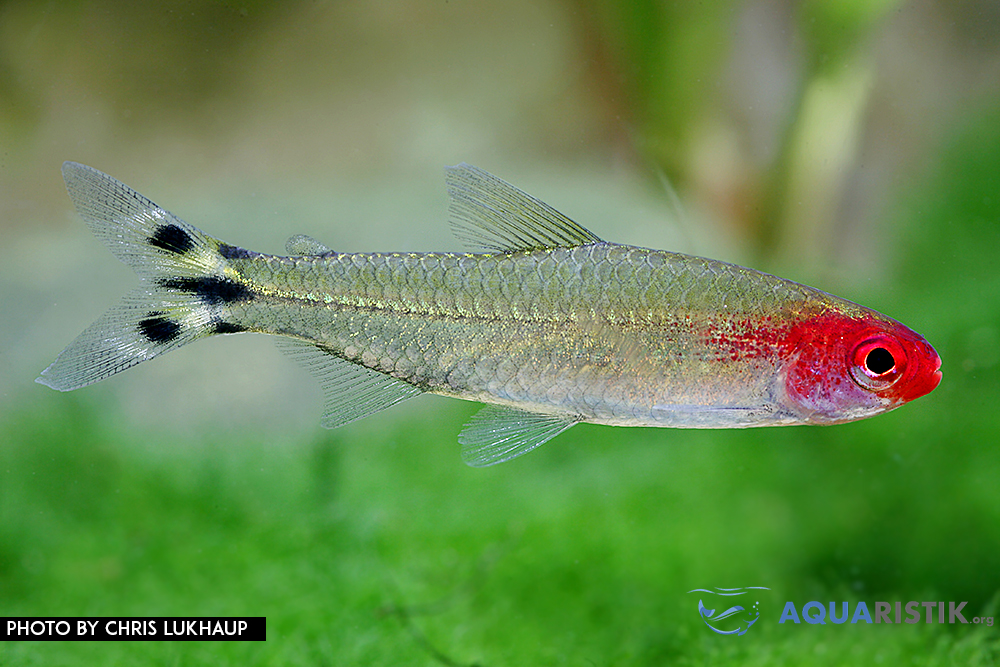Characteristics of Bleher's red-headed tetras or as it is also called in Latin des hemigrammus bleheri. Anyone who has seen this tetra for the first time will fall in love with this fish very quickly, because its Colors are unique and very beautiful. As you can certainly see for yourself in the picture. The red-headed tetra can quite quickly with the Red-mouthed tetra be confused. There are also different species of red-headed tetra such as the Georgs Red-headed Tetra. In English you read the name very often Firehead tetra.

Origin and distribution of the red-headed tetra
The red-headed tetra also belongs to the group of real tetra. Incidentally, this group is the largest in the area of tetras with over 1000 species. This fish does not originate in Europe either, but in Colombia and Brazil. There he does not live in the white water, but in the black water. Above all, the rivers such as the Rio Meta and the Rio Negro are considered to be their original homeland. There it occurs in large swarms. It is mainly found on the banks and in slow-flowing areas of rivers. The fish was named after the well-known pisciologist Heiko Bleher, hence the name Bleher Rotkopfsalmler. Today you can get a lot of wild caughts in addition to offspring. Usually you can recognize them by a not so strong coloration, although this is not generally true.
Characteristics and appearance of the red-headed tetra
Now let's move on to the appearance of the fish. As you can easily see in the picture, it is a real gem. The red coloring on the head and over the eyes is particularly striking. But that's not all, because the tail fin also has a very special colour. It has black and white stripes and looks like a zebra. This feature is also very pronounced. The body itself is more silvery to translucent, as are the dorsal fin and fins. The physique resembles that of one Neons and is therefore rather narrow and compressed.[the_ad id="1019″]
The distinction especially to George's red-headed tetra (Petitella georgiae) or the red-mouthed tetra (Hemigrammus rhodostomus) it's not always easy. However, there are various distinguishing features such as the color of the caudal fins of the Petitella georgiae, which rode further into the body. However, Bleher's red-headed tetra Hemigrammus bleheri is the most commonly available in specialist shops.
The red-headed tetra can live up to 10 years. Given its size, there are specimens up to 5 cm long, although most are on the smaller side.
Males tend to be slimmer than females. Otherwise, determining the sex is rather difficult.
Perhaps a word about socialization. Basically, the Bleher's red-headed tetra Hemigrammus bleheri can be socialized with all calm and non-aggressive animals that also come from the black water area.
Keeping and caring for Bleher's red-headed tetra Hemigrammus bleheri
Now let's get to Keeping of the red-headed tetra. We can also recommend this freshwater ornamental fish to beginners because keeping it is not particularly demanding. When setting up the aquarium, however, you should make sure that the substrate is kept rather dark, as you should adapt your environment to that of the black rivers. In addition, you should also Lighting dim a little. Either you use some floating plants or you can dim your aquarium lighting. This way the color comes out much better.
Let's move on to the size of the aquarium. Since the fish should only be kept in a swarm of around 10 or more animals, an appropriate aquarium is also required. We would not recommend keeping them under 200 liters, as these animals are also very good swimmers and therefore need enough space.
The water temperature should be set to 23 - 26 degrees, so that this species of tetras, as with the Tail light tetra or Peru Tetra mentioned copes very well with the average of 25 degrees.
The Ph value is in the range of 6 to 7 and is therefore rather acidic to look at. This is also a fundamental characteristic of black water. In addition, the GH value must also be adjusted accordingly and should not be above 10.
A word about feeding the animals. Here you can give well-known high-quality flake food or you can also concentrate on natural live food. In addition to Artemia, mosquito larvae are also given here. small crabs are the first choice for young animals. In the wild, the fish will mainly eat invertebrates. So let's summarize.
[amazon_link asins=’3935175418,3931792749,3800174936′ template=’ProductCarousel‘ store=’aquaristikorg-21′ marketplace=’DE‘ link_id=’4d39c0da-42be-11e8-b740-cddb9f08ea4c‘]
Profile of Bleher's red-headed tetra Hemigrammus bleheri
- Grows to around 5 cm
- Up to 10 years old
- Good swimmers
- Aquariums from 200 liters
- Temperature 23-26 degrees
- PH value 6 - 7
- Gh value up to 10
- Keep a swarm of 10 or more animals
Breeding of Bleher's red-headed tetra Hemigrammus bleheri
Not everyone will succeed in breeding these animals. Above all, you will have little success in a community tank. You should set up an appropriate breeding tank with very soft water and also good planting with fine-grained plants. Whether you try it with a pair or directly with a swarm usually doesn't matter. In any case, patience is required, as the animals only very rarely spawn. Getting the right time here is the difficulty, because there are also spawn robbers. Therefore, after the successful spawning, the parent animals must be removed.
After about 20 hours, the young hatch, which after 4 days can swim freely and like dust and fine food Artemia feed.



